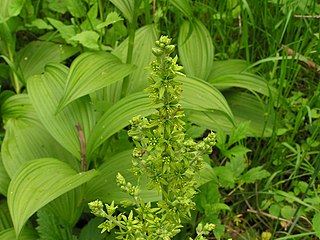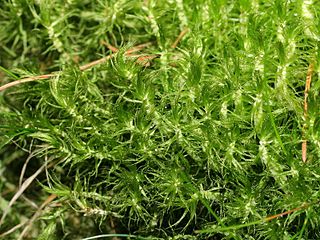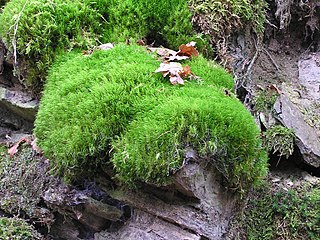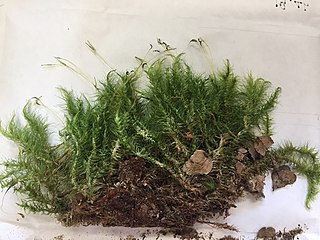
Veratrum viride, known as Indian poke, corn-lily, Indian hellebore, false hellebore, green false hellebore, or giant false-helleborine, is a species of Veratrum native to eastern and western North America. It is extremely toxic, and is considered a pest plant by farmers with livestock. The species has acquired a large number of other common names within its native range, including American false hellebore, American white hellebore, bear corn, big hellebore, corn lily, devil's bite, duck retten, itchweed, poor Annie, blue hellebore and tickleweed.

Dactylorhiza viridis, the frog orchid, is a species of flowering plant in the orchid family Orchidaceae. It has also been treated as the only species Coeloglossum viride of the monotypic genus Coeloglossum.

Dicranum is a genus of mosses, also called wind-blown mosses or fork mosses. These mosses form in densely packed clumps. Stems may fork, but do not branch. In general, upright stems will be single but packed together. Dicranum is distributed globally. In North America these are commonly found in Jack pine or Red pine stands.

Veratrum is a genus of flowering plants in the family Melanthiaceae. It occurs in damp habitats across much of temperate and subarctic Europe, Asia, and North America.

Trichoderma viride is a fungus and a biofungicide.

Trichoderma is a genus of fungi in the family Hypocreaceae that is present in all soils, where they are the most prevalent culturable fungi. Many species in this genus can be characterized as opportunistic avirulent plant symbionts. This refers to the ability of several Trichoderma species to form mutualistic endophytic relationships with several plant species. The genomes of several Trichoderma specieshave been sequenced and are publicly available from the JGI.

The wood lemming is a species of rodent in the family Cricetidae. It belongs to the rodent subfamily Arvicolinae, so is a relative of the voles, lemmings, and muskrats. It is found in the taiga biome of China, Estonia, Finland, Mongolia, Norway, Russia, and Sweden.

The stoplight parrotfish is a species of marine ray-finned fish, a parrotfish from the family Scaridae, inhabiting coral reefs in Florida, Caribbean Sea, Gulf of Mexico, Bermuda and as far south as Brazil. It mainly feeds on algae by scraping and excavating it with its teeth. Like most of its relatives, it is able to change sex.
Mesostigma is a genus of unicellular biflagellate freshwater green algae, with a single species Mesostigma viride, covered by an outer layer of basket‐like scales instead of a cell wall. As of February 2022, AlgaeBase classified it as the only genus in the family Mesostigmataceae, the only family in the order Mesostigmatales, the only order in the class Mesostigmatophyceae. It is now considered to be one of the earliest diverging members of green plants/algae (Viridiplantae).

Dicranaceae is a family of haplolepideous mosses (Dicranidae) in class Bryopsida. Species within this family are dioicous. Genera in this family include Dicranum, Dicranoloma, and Mitrobryum.

Asplenium viride is a species of fern known as the green spleenwort because of its green stipes and rachides. This feature easily distinguishes it from the very similar-looking maidenhair spleenwort, Asplenium trichomanes.

Dicranum scoparium, the broom forkmoss, is a species of dicranid moss, native to most of the northern hemisphere as well as Oceania. It usually forms tufts or mats on soil in dry to moist forested areas. As with many types of moss Broom moss grows in clumps with Broom mosses as well as other mosses. It can be distinguished by its leaves, which strongly curve to one side.

Bryotropha galbanella is a moth of the family Gelechiidae. It is found in Denmark, Norway, Sweden, Finland, Estonia, Latvia, Great Britain, France, the Netherlands, Germany, Poland, Austria, the Czech Republic, Italy, Romania and Russia. It is also found in Japan and North America. Furthermore, it was incorrectly recorded from Chile.
NVC community W17 is one of the woodland communities in the British National Vegetation Classification system. It is one of the six communities falling in the "mixed deciduous and oak/birch woodlands" group.

Microglossum viride is a species of fungus in the family Geoglossaceae. They are commonly called green earth tongues.
Trillium viride, commonly called the wood wakerobin, is a species of flowering plant in the family Melanthiaceae. It is found in the central United States, in certain parts of Missouri and Illinois. The specific epithet viride means "youthful" or "fresh-green", an apparent reference to the color of the plant's flower petals. For this reason, it is also called the green trillium, not to be confused with other green-flowered trilliums such as T. viridescens and the green form of T. sessile, both of which are found in Missouri.

Senjōjiki Cirque (千畳敷カール) is a cirque that lies just under Mount Hōken, Kiso Mountains in Nagano prefecture, Japan. It is called "Senjōjiki Kaaru" in Japanese. "Senjōjiki" means the wideness of 1000 tatami mats.

Dicranoloma dicarpum is relatively common moss which is widespread in the Southern Hemisphere. The genus Dicranoloma has 40 species, which share the features of long stems, wispy and twisted leaves, and large, erect capsules. The genus is dominant in wet forest habitats in Australia and New Zealand.

Calicium viride, commonly known as the green stubble lichen, is a species of pin lichen in the family Caliciaceae, and the type species of the genus Calicium. It is a common and widely distributed species in temperate areas of the Northern Hemisphere and southern South America.















